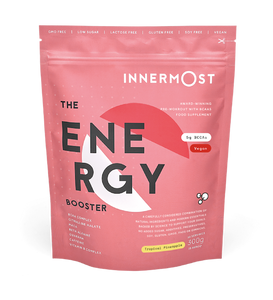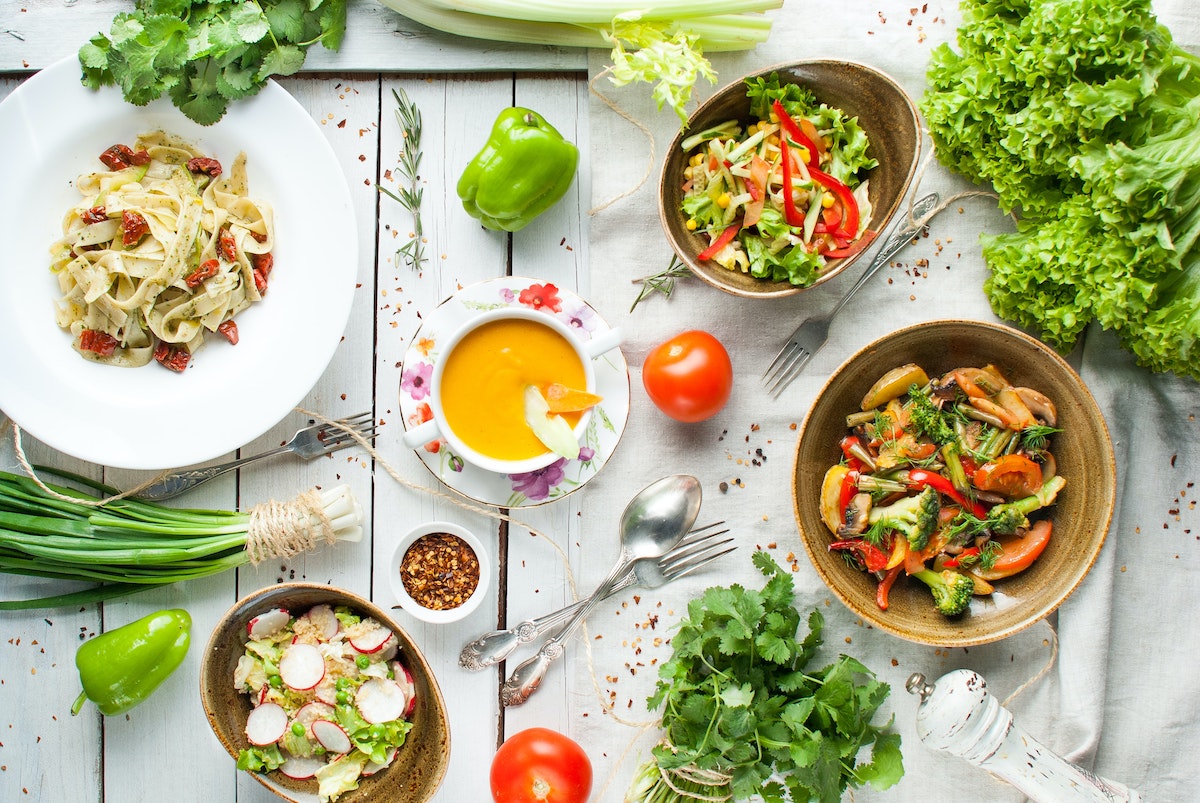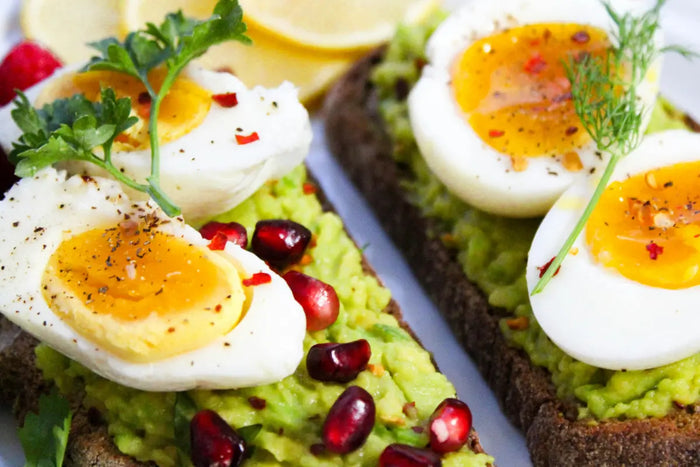Let’s face it. No one likes opening the fridge to find last night’s leftovers (that you really didn’t even like the first time), or worse… zero, zilch, nada.
It can be nearly impossible to make something that you are excited to eat out of the leftovers in the cupboard, and whilst we know that what we’re about to say isn’t helpful if you’re already in that sorry situation, we’re here to help you change your habits and live a healthier lifestyle.
In the theme of good old fashioned meal prepping (we love to be prepared, after all), we’ve put together a calendar of vegan dinner recipes to get you through the week. Well, the working week, that is.
Weekends are for wining and dining, after all.
Our favourite easy vegan dinners
When it comes to midweek dinner recipes, they need to be three things: affordable, quick and tasty. And every vegan dinner recipe on this list definitely fits the bill.
By planning your week in advance in terms of healthy vegan dinner plans, not only can you get the dreaded food shop out of the way at the start of the week to make sure your cupboards are stocked, but you’re never going to be faced with that awful dilemma of “what am I supposed to cook?!” when you’ve had the day from hell and just want to curl up on the sofa and chill.
Innermost’s 5 favourite vegan dinner ideas
5 days of the working week: 5 healthy vegan dinners. It’s that simple. Here we go!
- Monday’s simple tomato pasta
It's meat free Monday, people!
First up is a real prize. Simple and delicious - what more could you want?
This one might take you back to your uni days, but it’s an absolute staple, and can be jazzed up to your heart’s content or just enjoyed as-is for the ultimate lazy day comfort meal.
For this simple yet healthy vegan dinner recipe, you’re going to need the below:
- 1 white onion
- 3 cloves of minced garlic
- 1 tbsp of chilli pepper flakes (optional)
- Some sprigs of basil (to garnish, if you’re feeling fancy)
- 1 tin of tomatoes
- Vegan cheese (also optional)
- A handful of whole wheat pasta
- 1 aubergine, chopped
- 3 vegan sausages
To make this staple vegan dinner recipe, you’re going to need one pan of boiling water for the pasta (we love farfalle, but the shape is up to you), and a separate pan to cook your vegetables, or vegan sausages if you’ve opted to add these.
In one pan, boil the pasta, and in the other, start with the onions. Once these have browned, add the garlic, and next add the sausages and aubergines (or whichever vegetable you’ve gone for this week) until ready. Drain the pasta and throw it all together for a simple yet delicious meal, perfect for those midweek evenings.
Sounds like a good way to start the week, if you ask us.
- Tuesday’s vegetarian fajitas
Tuesday is Mexican night in our world, and what’s the better way to get your veggie fix and enjoy your Tuesday night dinner than fajitas? That’s right, there isn’t one.
For our delicious vegan fajitas, you will need:
- 3 bell peppers
- 1 white onion
- 2 handfuls of mushrooms (for the meat substitute, of course)
- Seasoning (we recommend chilli powder and cumin)
- Olive oil
- Wholemeal wraps
Chop and prepare your veggies. We recommend sliced, particularly for the bell peppers, but dicing can work particularly well for the onions. Next, using the olive oil and spices, create a marinade for your ingredients by mixing together in a bowl. Add salt and pepper to taste.
Add oil to your pan and toss together your ingredients in a pan and begin to cook. Make sure to keep an eye on your mixture to avoid burning, and, once cooked through, remove and portion out into your wraps.
For extra flavour, why not make your own guacamole or salsa to have on the side? You could even make enough for lunch the next day. Did someone say... meal prepping? We've taught you well.
- Wednesday’s pesto pasta salad
Ah, the humble pasta salad. Quick and simple to prepare, easy to batch-make and quite frankly always delicious, a pasta salad is one of our favourite healthy vegan dinner recipes, as it’s super easy to get a great mix of food groups all in one meal.
The more colour, the better.
You can kind of freestyle when it comes to what veggies (or fruits) you’d like to add into this salad, but here’s what you’ll need for the basis:
- Your pasta shape of choice
- 1 head of romaine lettuce
- 1 can of chickpeas
- 1 portion of pesto (green or red)
- Olive oil
- Paprika
Prep and cut your vegetables whilst your portioned pasta is boiling away. Remember to salt and oil your pasta water, too!
Take a separate bowl and pour in some olive oil, salt, pepper, paprika and mixed herbs. Mix together to create a base dressing, and set to one side. Next, once your pasta has boiled, drain and rinse with cold water until your pasta is cold. Add into a bowl and add your dressing and pesto, stirring together to ensure your pasta is covered evenly.
Next, chuck in your chopped up veggies of choice. Be sure to mix thoroughly and taste to season. Portion, and that’s it! You’re done and ready to go.
- Thursday’s tomato and squash soup
Everyone loves a soup, especially when fresh bread is involved, right? For a proper hearty meal that makes you feel at home, try out our tomato and squash soup recipe. You can even make multiple portions to freeze and store for a later date, if you like.
You’re going to need:
- 1 butternut squash
- 1 large white onion
- 5 cloves of garlic
- Paprika, to season
- 1 can of chopped tomatoes
- 400ml vegetable stock
- 1 chopped chilli
When it comes to creating a good, hearty soup, the key is the base. Begin creating your delicious soup by chopping the onion and sweating them in a pan. Once these are ready, chop and add your remaining vegetables and add to the pan to sweat, too.
The key is to get a soft consistency that is great for blending.
Next, add your spices. Chilli, garlic, herbs, paprika, you want it, you name it. This is another one of our recipes that you can freestyle and make your way. Add the vegetable stock and stir.
Next up, its time to blend, blend blend! Once you’ve got the soup to your desired consistency, place on the hob and simmer. Once this is heated through, you’re good to go. Enjoy with your favourite bread.
- Friday’s delicious vegan chilli
For this delicious vegan take on the classic chilli con carne, you’re going to need the following ingredients:
- 2 tbsp olive oil
- 1 onion (white or red), chopped
- 2 carrots, chopped
- 2 sticks of celery, chopped
- 2 garlic cloves, crushed
- 2 tsp cumin
- 2 tsp chilli powder (adjust if you like more or less spice!)
- 1 tbsp tomato puree
- 1 bell pepper (yellow, green, or red), chopped
- 1 400g tin of chopped tomatoes
- 1 400g can of kidney beans
- 1 400g can of black beans
- 1 cup of vegetable stock
- 1 portion of rice (white or brown)
Add oil to a pan and fry the onions, carrot and celery until softened (about 8 minutes). Add the garlic and cook for a minute or two, then stir through the spices and tomato puree and cook for another minute.
Add the bell pepper, chopped tomatoes and beans, along with your cup of vegetable stock. Allow the mixture to come up to a boil, and then simmer for around 20 minutes.
Whilst this is cooking away, prepare your rice in a separate pan (or the microwave, if you’ve grabbed a packet instead).
Once simmered for about 20 minutes, make sure to season for taste. Place the rice in a bowl and spread the chilli on top. You can even add some grated vegan cheese for some extra flavour. Voila!
Summary
Of course, you can change this order to however you like. Who says you can’t have Friday’s quick and easy vegan chilli on a Monday evening? Not us, that’s for sure.
If you’re looking for healthy vegan dinner inspiration, there you have it.

















